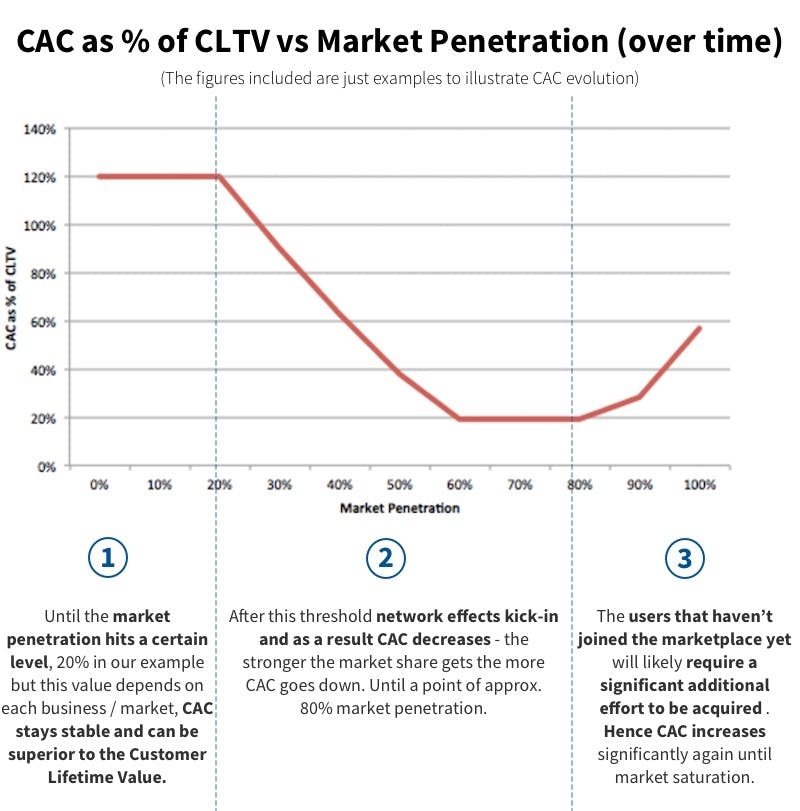Ten Lessons Learned Investing in early-stage Marketplaces
Investor Mathias Ockenfels’ insightful lessons are worth every marketplace entrepreneur’s time.
Published on
Last updated on

This is a guest post by Mathias Ockenfels, Partner at Speedinvest X - a team at Speedinvest focusing on marketplace platforms and network effects. For our tips on growing your business, check out the marketplace marketing & growth articles library.
For the past couple of years, I have had the chance and privilege, as an early-stage marketplace investor and doing M&A in this field, to work with amazing founders, from whom I have learned a lot. Here is a non-exhaustive list of some lessons taken from my various experiences.
It’s crucial for a marketplace founder to have a real long term vision and to be able to communicate it well. But knowing how and where to start is both essential and difficult. One of the best strategies to solve the chicken-and-egg problem is still to identify a specific niche for which you answer a real need and to expand later.
For example, don’t hesitate to go deep and focus on precise customer segments (core target groups, clearly defined customer personas) in specific geographies (e.g. on a city, area or country level) for particular use cases. The more focused you are, the easier it will be to provide your customers with the best solution. This is how Deskbookers, a workspace booking marketplace and a P9 investment, is able to grow its activity. They target precise customer segments such as planners for education, training, and health companies, and they address them through customized acquisition and retention strategies.
That being said, for some categories, it’s also possible to “hack” the chicken and egg problem by “throwing” a lot of money at it. A good example is the food delivery space, where you see early-stage companies raising millions of euros to build supply and demand as fast as possible. But beware, as it doesn’t necessarily guarantee healthy unit economics once it scales. The assumption here is that once initial liquidity has been reached, network effects will kick in, acquisition costs will go down and unit economics become healthier over time (more on that below).
One of the key lessons learned regarding marketplace metrics is the behavior of customer acquisition cost (CAC) over time. As previously mentioned, in a classic marketplace scenario, the “early” unit economics (once you start with paid marketing) usually don’t make a lot of sense: CAC often exceeds Gross Margin (negative contribution margin after variable marketing cost). Because of that, you might draw the potentially misleading conclusion that it is impossible to build a healthy, sustainable business in your category.
In such cases, one should consider that marketplaces follow a somewhat counterintuitive logic: once you hit a certain threshold of liquidity, network effects start to kick in, and as a result, CAC tends to go down and the unit economics become healthier and healthier.
This is why some companies try to “leapfrog” this stage by pouring a lot of (VC-)money into marketing early on in order to hit critical mass as soon as possible and see how sustainable CACs / Unit Economics evolve. It’s therefore essential to monitor how CAC and Unit Economics develop over time: if CAC is trending downwards, i.e. becoming healthier over time, it’s fine to accept “unhealthy” CAC at the very beginning.

You need to invest in order to build up the network, i.e. get supply and demand on your platform and achieve critical mass. This is to be seen as a long-term investment into a well-functioning, sustainable marketplace with a long-term competitive advantage.
When it comes to marketing, the basic marketplace playbook typically follows this order:
- First, focus on marketplace SEO and reach a certain level of organic traffic.
- Second, increase your traffic with paid marketing (SEM, referral, resellers, social).
- Once you reach initial liquidity, push hard on branding, i.e. above-the-line marketing efforts (television, print, radio, or internet ad campaigns).
Recently, I’ve seen several early-stage marketplaces raising significant amounts of capital early on, in order to put a lot of money into creating and pushing their brand before they really had strong foundations of SEO/organic traffic and little data points on performance marketing. Their plan was to create liquidity purely through their brand and above-the-line marketing. Based on my observations, most of them failed with this approach. Branding - as a stand-alone concept - doesn’t create liquidity. It fuels it and should be part of a healthy marketing mix.
As I mentioned in my 2017 predictions, many of my fellow marketplace investor colleagues are concerned with the fact that more and more marketplace categories are already locked by big players (Uber for transportation, Airbnb for accommodation etc.) and that “blue ocean categories” for marketplaces in Europe are becoming rare.
The bar to get the attention of investors in 2017 is definitely getting higher. In general, you not only need to show much better metrics, but also a better understanding of your engine of growth, and that the segment you’re operating in is not saturated and has potential to be really big (meaning billions of euros in market potential). Yes, unfortunately, more and more items to be checked off an investor’s list...
A key aspect of great marketplace founders is their ability to grow and build their team according to their current stage and needs. For instance, it can take very different people to build initial supply than it takes to build demand. The same goes for marketplace branding which requires very specific skills. This is why attracting, but also letting people go at the right time, is crucial for a marketplace.
In that perspective, a positive trend in Europe is the increasing availability of skilled marketplace talents. Among others, we are currently seeing more and more eBay, Amazon, Uber, Airbnb, and Blablacar alumni joining early-stage marketplaces or starting their own. It’s not easy to poach them, but the pool of talents who “have done it before” is definitely bigger than a couple of years ago.
In the last years, we’ve seen an explosion of infrastructure providers, SaaS and APIs, that are literally eating the marketplace tech stack and thus “commoditizing” the marketplace product. From full-stack platform providers such as Sharetribe or Mirakl to more specific functions such as payment with MangoPay or Stripe Connect, shipping management tools like Shippo, analytics like Upright Metrics, or even booking engine APIs such as TimeKit, you’ll find hundreds of tools that help you build the first version of your product in no time.
As building a marketplace product from the ground up is getting easier, the focus at early stage shifts from building a complete stack to optimization and efficiency. Choosing the right tools and making them work well together is an increasingly important skill. For instance, I’ve already seen a marketplace MVP built solely on top of Typeform (and generating revenue).
In terms of product, a noticeable evolution is the rise of the SaaS enabled marketplace model. At the beginning of the marketplace phenomenon, many operators built their product around the transaction only. Users would mainly browse listings (discovery), check reviews, and buy the product/service online (= “owning the transaction”). But as competition gets fiercer and users get more demanding, marketplace operators have to offer more features and services around their core value proposition.
Airbnb is a good example of this trend. It provides plenty of extra features for the supply-side, such as pre-filled messages to answer common requests, calendar notes, and checkin-checkout overview. Many marketplaces now offer real “SaaS” products that could almost be used as standalone apps. The line between pure marketplaces and pure SaaS tools is becoming blurry.
When you’re building supply, should you focus on the quality of your inventory or on quantity first? If you’re an early-stage marketplace founder, it’s probably a question you’ve asked yourself many times already. Having worked with plenty of great entrepreneurs I noticed that if you focus on solving a specific problem for a defined niche, you should value quality over quantity at the beginning. By doing so it will be easier to generate happiness, word of mouth, and better early retention or repeat rate metrics.
That being said, if your approach cannot be as laser-focused, then focusing on quantity first can help you build liquidity, to later double down on quality. It’s especially true for use cases where customers value a large catalog, i.e. a big inventory, in order to increase the chances of finding the perfect “match”. For example, food delivery marketplaces don’t focus on niche categories (e.g. vegan food) because they need to build a very large supply fast to cover all areas and the most wanted categories (e.g. Pizza) first.
Less than 10 years ago, renting your bedroom or doing carsharing with total strangers would have seemed like a crazy idea, but nowadays it’s accepted and adopted by millions of consumers worldwide. Whether it’s for e-commerce, accommodation, transportation, or food delivery, many B2C categories are covered by one or more established marketplace businesses. It’s getting increasingly harder for a young startup to break through.
Looking at the marketplace landscape, I strongly believe that many of the coming big opportunities will be in B2B. Whether it’s for agriculture, government tech, legal, or other verticals, the demand is increasing and not yet properly addressed. Traditionally, the B2C trends always hit the B2B market with a bit of delay; the age of new big B2B marketplaces has yet to come.
A large portion of the early-stage marketplaces I meet is marketplaces with a local component, so-called “hyper-local marketplaces”. By their nature, many are pushing for an “offline to online switch” as they enable users to book, rent or buy an “offline” service or product in a specific location, directly from a website or a mobile app.
Geographic expansion is a crucial topic for hyper-local marketplaces, especially in Europe. When you look at how the most successful marketplaces tackled EU expansion, you quickly understand that there’s no silver bullet. Uber adopted a very “on the ground” strategy by sending teams (ran by so-called “launchers”) from one city to another, to aggressively apply a playbook they validated in other places. Delivery Hero handled expansion by acquiring several local players. BlaBlaCar tries to capture the biggest EU markets, one after the other.
If you’re a hyperlocal marketplace operating in Europe, the main takeaways here are:
- First, thoroughly assess where to start, preferably a big market (even if it’s not your home market).
- Secondly, have concrete plans on the type of expansion that fits the characteristics of the service you offer the best. (e.g. is it a city-by-city- or a country-by-country play?).
As you can see from this list, both opportunities and challenges lay ahead in the marketplace space. Not every single lesson will apply to every marketplace, but experience proves that every marketplace entrepreneur has to fight similar battles. I hope this short overview will help you win some of these faster. Rest assured you are not alone on the battlefield. If you have any questions or want to share your experience with me you can contact me on Twitter: @ockenrock.
You might also like...

Marketplace funding: The complete guide
Struggling with funding your marketplace? This guide helps you decide how much marketplace funding you need – and when and where to source it.

How to grow your marketplace on a budget
The road to 1,000 customers starts with 10 happy ones (that you didn’t have to pay for).

What to do if your marketplace business slows down
Five recommendations to consider for your marketplace during times of slower business. Some can help you make it through these difficult times, others prepare your business for better ones ahead.
Start your 14-day free trial
Create a marketplace today!
- Launch quickly, without coding
- Extend infinitely
- Scale to any size
No credit card required
